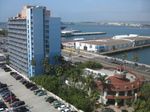Holiday Inn on the Bay (San Diego)

Note (2014): This hotel is now the Wyndham San Diego Bayside.

It’s located on the bay (of course), near the San Diego Maritime Museum where they have several classic ships permanently anchored and available for tours. If you happen to have an upper-floor room, the views are quite nice. (We were on the second floor, so our view was of the roof of the hotel’s conference center. It’s funny how quickly we got used to the sound of the air conditioner.)
It’s an easy walk to Little Italy (we went out to one of our favorite San Diego restaurants, Indigo Grill, on Wednesday) or the trolley, and on the convention shuttle route.

The only annoyances were:
Internet access during the convention was absolutely swamped. Sometimes pages just wouldn’t load, and the Flickr uploader actually gave up several times. This would have been less of a problem if I hadn’t been so determined to post photos and blog during the con, though at least with photos it turned out I could (usually) start them before going to bed and let them run overnight. The one night that it just gave up, I tried when we got up at 6 AM and they posted extremely quickly.
The bathroom had a sliding door that didn’t seal. Like the room at the Omni, it blocked light but not sound or airflow. On the plus side, it was actually big enough that we could brush our teeth at the same time.
Overall, though, we really liked it, and agreed that it would be near the top of our list when it came to hotels on the shuttle route. Though if possible I’d really prefer something close enough that we wouldn’t have to rely on the shuttle or other transportation.
See Also: Convention Photos & Write-Ups